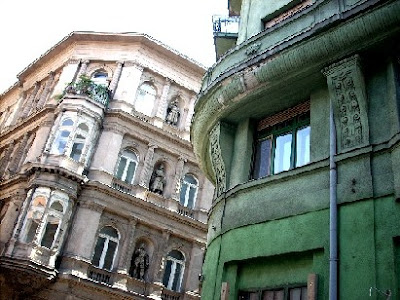THE GRESHAM PALACE FOUR SEASONS, Budapest
 |
| Keith (photo by Musictimes) |
Arriving at the Gresham Palace from Budapest Airport, we saw considerable
crowds camped on the hotel grounds. We
knew they weren’t waiting for us, so we figured someone important must be
coming or going.
 |
| The Gresham's special grill doors |
I could glimpse what was undoubtedly the royal suite and out marched single-file a procession of the most eccentric and oddly attired older gentlemen. At least one of them seemed to be wearing a clown’s wig, and the four men made me immediately think of the Marx Brothers.
“Well, hello,” said Brenda in her rather confident, British matter-of-fact
manner. “How very nice to see you.” I hadn't yet twigged on, and momentarily thought she had run into an old friend.
Keith Richards probably thought the same thing. He appeared
genuinely taken aback, as though he should know this rather elegant older woman
--indeed just about his own age-- who showed no signs of being a tongue-tied groupie.
“Well, hallo to you,” he said.
“How ARE you? How are you DOING?” His darkly died hair struck out in
all directions from under the ubiquitous bandana.
“Oh, never better,” said Brenda.
“So good to see you.”
“Good to see you again,” said Keith, clearly straining to remember the
identity of this Anglo-Saxon couple in their swimming robes on the fifth floor
of the Budapest Gresham Palace.
Just as we began to move away, he called after us, “and …. really, we MUST quit meeting like this!”
Just as we began to move away, he called after us, “and …. really, we MUST quit meeting like this!”
 |
| That's Brenda in the Gresham Palace lobby |
 |
| The Gresham Palace seen at twilight from the Chain Bridge |
SIDEBAR: A look at Budapest's special architecture
 |
| The Danube, Budapest |
On my first visit in the 1970's, the building facades were so dirty and gray that the specialness of the city's skyline was almost completely camouflaged. Today the transformation is spectacular.
On my most recent return in 2008, I was surprised to see how beautifully and colorfully the city had been restored since the disappearance of the so-called "iron curtain".
I photographed buildings that appealed to our aesthetic senses, but it never occurred to me to find out the names or histories of what I was photographing. So here are a few anonymous but often colorful and original buildings, frequently representing the turn-of-the-century art-nouveau era when Budapest was very much the fashionable place to be and to be seen.
Your input is welcomed: frank.pleasants@libertysurf.fr
[Photos are mine, unless otherwise credited]
CROSS REFERENCING … a look at other postings
Budapest was also featured in: blog No. 20, "Decaffeinated coffee ... in Hungarian?" Jan. 11, 2013
(to access, click on above title).


















